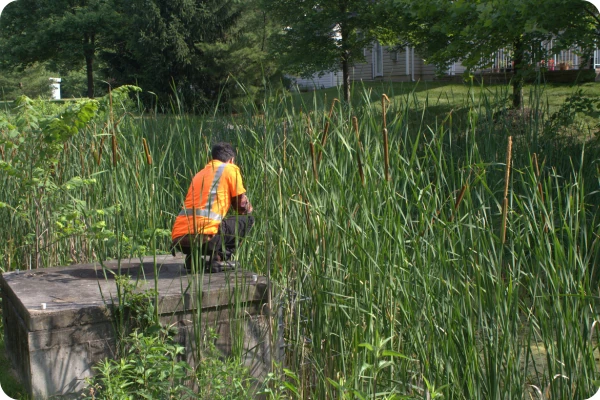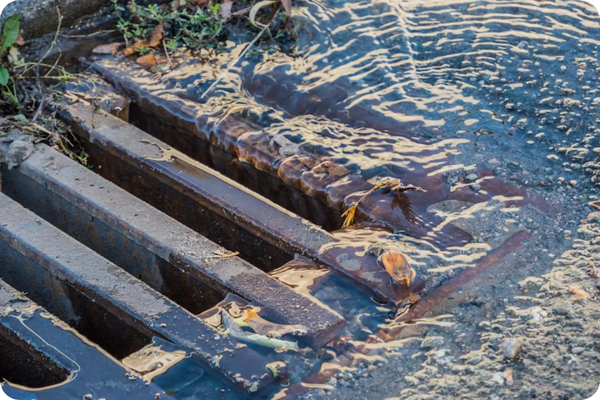Stormwater facilities are designed to work quietly in the background – managing runoff, preventing flooding, and protecting downstream waterways. But even the best-designed systems can underperform or fail altogether without regular inspection.
One of the most common questions property owners and managers ask is simple: How often should stormwater facilities be inspected?
The short answer is: it depends. The longer answer – and the one that matters for compliance – is tied to regulations, system type, site conditions, and ongoing maintenance history.
Understanding inspection frequency isn’t just about checking a box. It’s about keeping systems functional, avoiding costly repairs, and staying ahead of compliance issues before they escalate.

Why Stormwater Inspection Frequency Matters
Stormwater facilities are exposed to constant stress: sediment buildup, vegetation growth, trash accumulation, erosion, and structural wear. Without regular inspections, small issues can quickly turn into:
-
Reduced treatment capacity
-
Blocked or damaged inlet and outlet structures
-
Localized flooding or erosion
-
Permit violations and enforcement actions
Routine inspections help identify problems early – when they’re easier and far less expensive to correct.
Regulatory Requirements Set the Baseline
In most cases, local and state regulations establish the minimum inspection frequency for stormwater facilities. These requirements are often tied to:
-
MS4 permit conditions
-
Stormwater management approvals
-
Operation & Maintenance (O&M) agreements
-
Recorded stormwater easements
While specifics vary by jurisdiction, many regulatory programs require:
-
Annual inspections for most permanent stormwater BMPs
-
Post-storm inspections after major rainfall events
-
More frequent inspections for higher-risk or proprietary systems
Meeting the minimum requirement is essential – but it’s rarely sufficient on its own.
Inspection Frequency by Stormwater Facility Type
Different stormwater practices experience different failure points, which directly affects how often they should be inspected.
Ponds (Retention & Detention)
Stormwater ponds, both wet and dry, typically require at least one comprehensive inspection per year, with additional visual checks throughout the year. Inspections often focus on:
-
Embankment stability
-
Inlet and outlet condition
-
Vegetation coverage
-
Sediment accumulation
Because ponds are large and visible, problems can develop gradually – and go unnoticed without scheduled inspections.
Bioretention & Green Infrastructure
Facilities like bioretention areas, bioswales, and rain gardens often need more frequent inspections, particularly during establishment periods or after heavy rainfall. These systems are sensitive to:
-
Mulch displacement
-
Invasive vegetation
-
Soil compaction
-
Sediment clogging
Quarterly inspections are common, especially on commercial sites with higher runoff volumes.
Underground & Structural Systems
Vaults, hydrodynamic separators, and media filtration systems generally require regular inspections tied to sediment and debris loading, not just time intervals. Without inspection:
-
Treatment capacity can be reduced
-
Internal components may be damaged
-
Maintenance needs can be missed entirely
These systems often require annual or semi-annual inspections, with cleanings triggered by inspection findings.
Factors That Can Increase Inspection Frequency
Even when regulations specify a minimum schedule, several site-specific factors may justify more frequent inspections:
-
High-traffic commercial or industrial land use
-
Steep slopes or erosion-prone soils
-
Aging or poorly maintained systems
-
Sites with a history of compliance issues
-
Areas with heavy leaf litter or debris loads
In these cases, proactive inspections help prevent emergency maintenance and reduce long-term costs.
Inspections vs. Maintenance: Understanding the Difference
An inspection identifies conditions and documents performance. Maintenance corrects deficiencies.
While they’re closely related, inspections should occur before problems become maintenance emergencies. A consistent inspection schedule allows property managers to:
-
Plan maintenance proactively
-
Budget more accurately
-
Avoid reactive, high-cost repairs
-
Maintain compliance documentation
Skipping inspections often leads to deferred maintenance – and higher costs down the road.
Who Is Responsible for Stormwater Inspections?
Responsibility typically falls on the property owner, even when maintenance is contracted out. Many permits and agreements require owners to:
-
Retain inspection reports
-
Submit documentation to municipalities when requested
-
Demonstrate ongoing compliance
Working with a qualified stormwater professional ensures inspections are performed correctly and documented in a way that meets regulatory expectations.
The Bottom Line: Inspect Early, Inspect Consistently
There’s no universal inspection schedule that works for every site – but there is a common theme across all stormwater facilities: consistent inspections protect performance, compliance, and investment.
By understanding regulatory requirements, facility type, and site-specific risks, property managers can establish inspection schedules that do more than meet minimum standards – they help systems function as designed for the long term.
Want to go deeper?
Regular inspections are just one part of effective stormwater management. Pairing inspections with proactive maintenance planning is key to avoiding costly failures and compliance issues.
📞 Call us at (410) 231-3455 or 💬 Contact us online.




